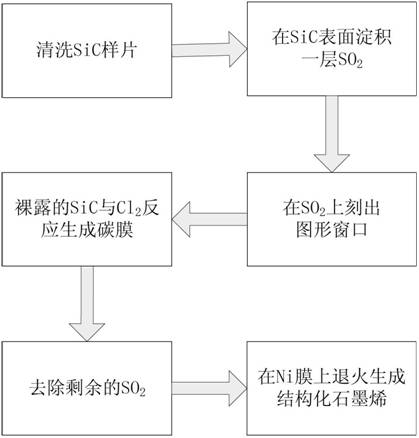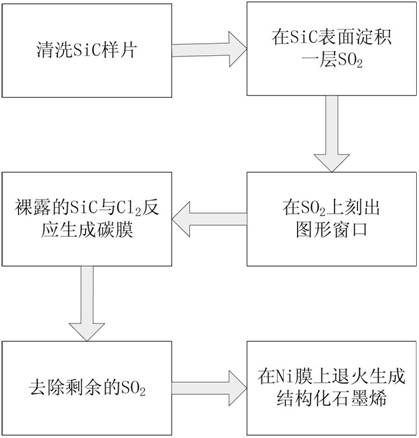Method for preparing structured graphene by reaction of SiC and Cl2 based on Ni film annealing
An annealing and fossilization technology, applied in the field of microelectronics, can solve the problems of reduced electron mobility of graphene, expensive single crystal SiC, affecting device performance, etc., and achieves the effect of easy control of thickness, fast reaction rate, and guaranteed device performance
- Summary
- Abstract
- Description
- Claims
- Application Information
AI Technical Summary
Problems solved by technology
Method used
Image
Examples
Embodiment 1
[0026] Step 1: Wash the 6H-SiC sample to remove surface contamination.
[0027] (1.1) Use NH for 6H-SiC substrate 4 OH+H 2 o 2 Soak the sample in the reagent for 10 minutes, take it out and dry it to remove the organic residue on the surface of the sample;
[0028] (1.2) Use HCl+H on the 6H-SiC sample after removing the surface organic residues 2 o 2 The reagent soaked the sample for 10 minutes, took it out and dried it to remove ionic contamination.
[0029] Step 2: Deposit a layer of SiO on the surface of the 6H-SiC sample 2 .
[0030] (2.1) Put the cleaned 6H-SiC sample into the PECVD system, adjust the internal pressure of the system to 3.0Pa, adjust the RF power to 100W, and adjust the temperature to 150°C;
[0031] (2.2) Introduce SiH with flow rates of 30sccm, 60sccm and 200sccm into the system 4 , N 2 O and N 2 , the duration is 20min, making SiH 4 and N 2 O reaction, deposit a layer of 0.4 μm thick SiO on the surface of 6H-SiC sample 2 mask layer.
[003...
Embodiment 2
[0051] Step 1: Clean the 4H-SiC sample to remove surface pollutants.
[0052] For 4H-SiC substrates, use NH first 4 OH+H 2 o 2Soak the sample in the reagent for 10 minutes, take it out and dry it to remove the organic residue on the surface of the sample; then use HCl+H 2 o 2 The reagent soaked the sample for 10 minutes, took it out and dried it to remove ionic contamination.
[0053] Step 2: Deposit a layer of SiO on the surface of the 4H-SiC sample 2 .
[0054] Put the cleaned 4H-SiC sample into the PECVD system, adjust the internal pressure of the system to 3.0Pa, adjust the RF power to 100W, and adjust the temperature to 150°C; feed SiH with flow rates of 30sccm, 60sccm and 200sccm into the system 4 , N 2 O and N 2 , the duration is 75min, making SiH 4 and N 2 O reaction, deposit a layer of 0.8 μm thick SiO on the surface of 4H-SiC sample 2 .
[0055] Step 3: On SiO 2 The graphics window is engraved on the layer.
[0056] In SiO 2 Spin-coat a layer of photor...
Embodiment 3
[0067] Step A: Clean the surface of the 6H-SiC substrate, that is, use NH 4 OH+H 2 o 2 Soak the sample in the reagent for 10 minutes, take it out and dry it to remove the organic residue on the surface of the sample; then use HCl+H 2 o 2 The reagent soaked the sample for 10 minutes, took it out and dried it to remove ionic contamination.
[0068] Step B: Put the cleaned 6H-SiC sample into the PECVD system, adjust the internal pressure of the system to 3.0Pa, adjust the radio frequency power to 100W, and adjust the temperature to 150°C; the flow rates into the system are respectively 30sccm, 60sccm and 200 sccm of SiH 4 , N 2 O and N 2 , the duration is 100min, so that SiH 4 and N 2 O reaction, a layer of 1.2 μm thick SiO was deposited on the surface of the 6H-SiC sample 2 .
[0069] Step C: Same as Step 3 of Example 1.
[0070] Step D: place the sample piece after opening the window in the quartz tube 1, and place the quartz tube in the resistance furnace 2; feed th...
PUM
 Login to View More
Login to View More Abstract
Description
Claims
Application Information
 Login to View More
Login to View More - R&D
- Intellectual Property
- Life Sciences
- Materials
- Tech Scout
- Unparalleled Data Quality
- Higher Quality Content
- 60% Fewer Hallucinations
Browse by: Latest US Patents, China's latest patents, Technical Efficacy Thesaurus, Application Domain, Technology Topic, Popular Technical Reports.
© 2025 PatSnap. All rights reserved.Legal|Privacy policy|Modern Slavery Act Transparency Statement|Sitemap|About US| Contact US: help@patsnap.com



